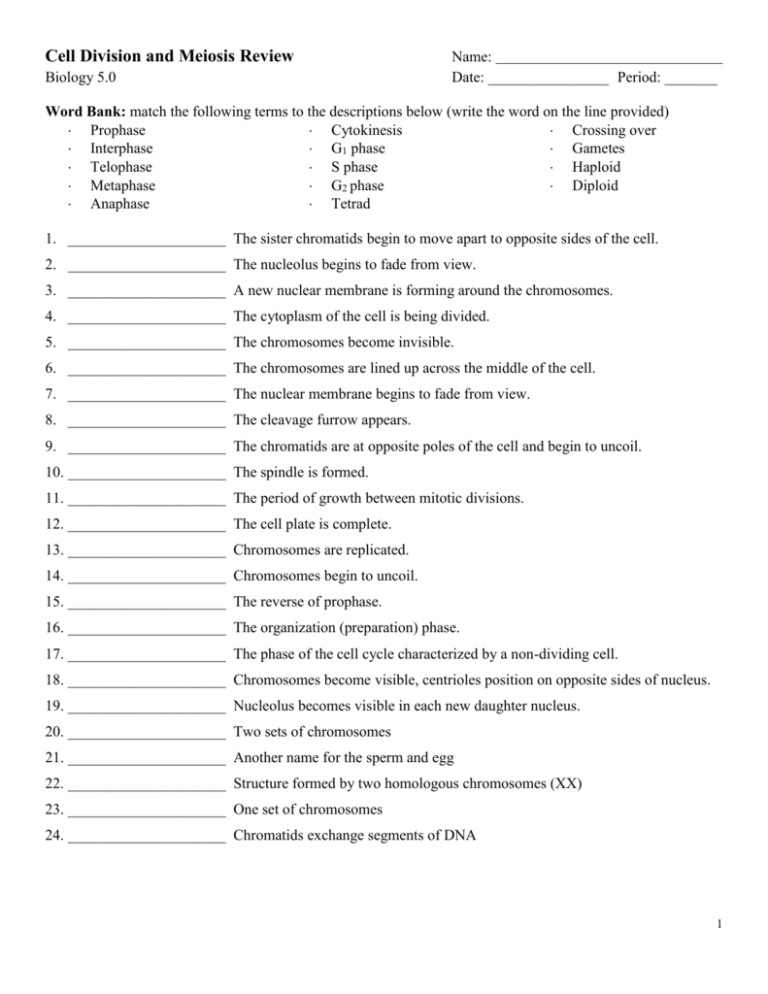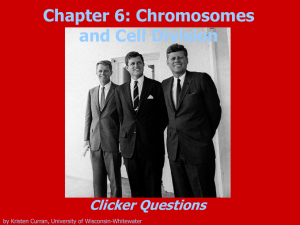Cell Division and Meiosis Review
advertisement

Cell Division and Meiosis Review Biology 5.0 Name: Date: ________________ Period: _______ Word Bank: match the following terms to the descriptions below (write the word on the line provided) Prophase Cytokinesis Crossing over Interphase G1 phase Gametes Telophase S phase Haploid Metaphase G2 phase Diploid Anaphase Tetrad 1. _____________________ The sister chromatids begin to move apart to opposite sides of the cell. 2. _____________________ The nucleolus begins to fade from view. 3. _____________________ A new nuclear membrane is forming around the chromosomes. 4. _____________________ The cytoplasm of the cell is being divided. 5. _____________________ The chromosomes become invisible. 6. _____________________ The chromosomes are lined up across the middle of the cell. 7. _____________________ The nuclear membrane begins to fade from view. 8. _____________________ The cleavage furrow appears. 9. _____________________ The chromatids are at opposite poles of the cell and begin to uncoil. 10. _____________________ The spindle is formed. 11. _____________________ The period of growth between mitotic divisions. 12. _____________________ The cell plate is complete. 13. _____________________ Chromosomes are replicated. 14. _____________________ Chromosomes begin to uncoil. 15. _____________________ The reverse of prophase. 16. _____________________ The organization (preparation) phase. 17. _____________________ The phase of the cell cycle characterized by a non-dividing cell. 18. _____________________ Chromosomes become visible, centrioles position on opposite sides of nucleus. 19. _____________________ Nucleolus becomes visible in each new daughter nucleus. 20. _____________________ Two sets of chromosomes 21. _____________________ Another name for the sperm and egg 22. _____________________ Structure formed by two homologous chromosomes (XX) 23. _____________________ One set of chromosomes 24. _____________________ Chromatids exchange segments of DNA 1 Word Bank: match the following terms to the descriptions below (write the word on the line provided) Anaphase Chromatid Histone Nucleosomes Cell cycle Chromatin Interphase Prophase Centrioles Chromosome Metaphase Spindle fibers Centromere Cytokinesis Mitosis Telophase 25. ____________________ The beadlike structures formed by DNA and histone molecules. 26. ____________________ Mesh-like structure that helps move the chromosomes apart. 27. ____________________ Process by which the cell nucleus is divided. 28. ____________________ First and longest phase of mitosis. 29. ____________________ Phase of mitosis in which the chromosomes start to uncoil. 30. ____________________ Material that makes up chromosomes. 31. ____________________ Phase of mitosis where sister chromatids separate. 32. ____________________ Protein around which the chromosomal DNA is coiled. 33. ____________________ Process in which the cytoplasm divides. 34. ____________________ Period of the cell cycle between divisions. 35. ____________________ Phase of mitosis in which chromosomes line up along the equator of a cell. 36. ____________________ Each chromosome consists of two of these at the beginning of mitosis. 37. ____________________ Microtubule-containing structures located near the nucleus during prophase (animal organelle involved in cell division). 38. ____________________ ____________________ Name the two stages of cell division. 39. The M phase is also known as ______________________. 40. Each pair of chromatids is attached at an area called the ________________________. 41. The three phases of ___________________________ are G1, S, and G2. 42. The ___________________________ is a series of events that cells go through as they divide and grow. 43. The beadlike structures formed by DNA wrapped around molecules (proteins) are called nucleosomes. 44. In eukaryotic cells, the genetic structure consists of coils and supercoils of nucleosomes which together form . 45. The ______________________ is a fanlike microtubule structure that helps separate the chromosomes. 46. ____________________________ is the division of the nucleus. 2 Multiple Choice ______47. What process ensures that each daughter cell gets a complete set of genetic information and that each daughter cell also has an increased surface area? a. meiosis c. cytokinesis b. mitosis d. cancer ______48. Before cell division, each chromosome consists of two identical “sister” a. centromeres c. chromatids b. cell cycles d. spindles ______49. What phase of mitosis takes the longest period of time? a. prophase c. anaphase b. cytokinesis d. interphase ______50. During cell division, the DNA in a eukaryotic cell is tightly packed and coiled into structures called a. centromeres c. haploids b. histones d. chromosomes ______51. Between cell divisions, the DNA in a eukaryotic cell is uncoiled and spread out. In this form it is called a. chromatid c. histone b. chromatin d. nonhistone ______52. If an organism has a diploid, or 2N, number of 16, how many chromosomes do its sperm cells or egg cells contain? a. 8 b. 16 c. 32 d. 64 ______53. Prokaryotic cells reproduce by a process called a. mitosis c. binary fission b. meiosis d. binary fusion ______54. In eukaryotic cells, DNA is copied during a phase of the cell cycle called a. M phase c. G1 phase b. S phase d. G2 phase ______55. During crossing over, portions of chromatids a. double the amount of DNA in each chromosome b. move from autosomes to sex chromosomes c. break off and attach to adjacent chromatids on homologous chromosomes d. separate from each other and move to opposite poles of the cell ______56. In which phase of meiosis do tetrads form? a. Prophase I c. Metaphase II b. Telophase I d. Anaphase II ______57. In oogenesis, a diploid reproductive cell divides meiotically to produce a. one diploid gamete c. one haploid gamete b. four diploid gametes d. four haploid gametes 3 Distinguish between each pair of terms. 58. asexual reproduction, sexual reproduction: 59. centromere, chromatid: 60. diploid, haploid: 61. binary fission, mitosis: 62. Distinguish between the following terms: chromatid, chromatin, centromere, and chromosome. Use the terms mitosis and meiosis to answer the following questions. 63. ____________________ Four new cells are formed from each original 64. ____________________ This process makes gametes (egg and sperm) 65. ____________________ Two new cells are produced from each original 66. ____________________ New skin cells are made this way 67. ____________________ This type of reproduction helps you grow 68. ____________________ This makes cells with half the original chromosome number 69. ____________________ This makes cells with the same chromosome number as the original. Use the terms sperm, egg, or both sperm and egg to answer the following questions. 70. ____________________ Formed by meiosis 71. ____________________ Formed by male 72. ____________________ Formed by female 73. ____________________ Needed for fertilization 74. ____________________ Four formed from original cell 75. ____________________ Human kind has 23 chromosomes 4 76. Make a T chart and identify three differences between mitosis and meiosis. 77. Why are cells limited in size? Diagrams 78. In the spaces provided, label each figure in MITOSIS. 5 79. Phases of Meiosis The stages of meiosis below are NOT in order. What is the correct order of the pictures? Label the phases of meiosis. Include I and II in the name. Name of Phase Description (these do not correspond with the pictures above) (these do not correspond with the pictures above) 1. Homologous chromosomes pair up and form tetrad 2. Spindle fibers move homologous chromosomes to opposite sides 3. Nuclear membrane reforms, cytoplasm divides, 4 daughter cells formed 4. Chromosomes line up along equator, not in homologous pairs 5. Crossing-over occurs 6. Chromatids separate 7. Homologous chromosomes line up alone equator 8. Cytoplasm divides, 2 daughter cells are formed 6









